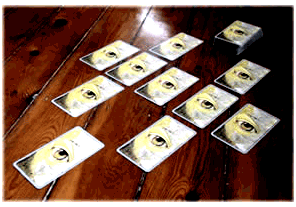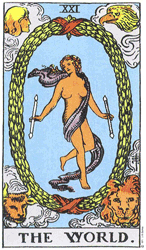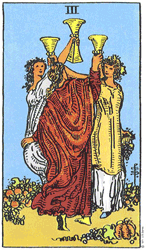Tarot gets its information from many sources, though you get to choose which one you want for yourself. The archetypes depicted in the cards exist as living entities
in psychic space, to whom we relate; and also to living people and circumstaces. But in a sense these characters dance to the tune of your deeper cosmic affiliation: love or fear.
Cards and the patterns they arrange themselves in mirror our state of mind astonishingly. They also mirror reality to a startling degree. The comment here is that one's state of mind helps shape
what we perceive as reality. This is why many people begin tarot work with an invocation to goddess/god, the higher self, the holy spirit or something else on the vibe of 'the greatest good for
all concerned'. It is well advised to do so, as tarot and any other esoteric tool opens us up to other dimensions of reality, sometimes slippery ones where we're less accustomed to negotiating.
If you ever get lost in a situation or find yourself experiencing fear, whether reading for yourself or a querent, call on the holy spirit's assistance and you'll get it. That being said, let's
get on with the show.

Here Is The Spread. It's called the Celtic Wings. It's a 10-card layout, based loosely on the Celtic Cross. The positions of the cards, in the sequence that they are drawn, are like this diagram:
Here is a Digital Version of the spread programmed by Tracy Delaney.
The digital version uses the Rider-Waite deck, drawn by Pamela Coleman Smith and licensed by U.S. Games Systems.
My favorite two books are The Book of Thoth by Aleister Crowley, and
Tarot: Mirror of Your Relationships by Gerd Zeigler. The reason I got interested in the Thoth deck
was because I noticed the books about it made more sense (to me) than most books about other decks. There was clarity and the logic was easier to follow, as well as a respect for tradition. Crowley was a true esoteric lore master, and Zeigler is a therapist. So,
on that basis, I decided to explore the deck itself more deeply and used it to develop this spread.
 1st Position- Here and Now 1st Position- Here and Now
The starting point, the general conditions, and potentially a significator card representing someone key to the reading (not necessarily the querent, but it could be them).
This is the feeling of the moment. This card, however, is not necessarily turned over first. It works as the first card, but it may be turned over second, or at some other point. A little suspense
may be helpful. In the old spread, this is called 'this is what covers you', a somewhat ambiguous way of saying 'here and now.'
2nd Position- Foundation
This card is the ground on which the circumstances of the spread are standing. This is the 'how you got here', or where you came through to get here, card. This is
a historical card, telling the basic perspective on the past that's operating now, revealing some past event, or telling the story of the past as it pertains to this situation. Clue: if something
appears in this position, it is in the past, but it is still a factor, or being treated as a factor. Therefore, you cannot just dismiss it; you have the information for a reason. Traditionally, the
position has a window of about three months. But it could be longer, and it's good to stay loose. The card itself may give a clue to the time frame. The thing about spreads is that you get to define
or refine the meaning of each position. It's better if you understand in advance what you're going to read in that position, and then when the card shows up you match the two up.
3rd Position- Most Recent Meaningful Development
Whatever appears here is still in the process of working through, but toward the end of that process. It's much more of a current factor than the
2nd place, which points directly to the past. The traditional spread calls the equivalent of the 3rd position, 'this is what surrounds you and is in the process of leaving'. It is still having a
tangible effect, and who or whatever is there is still available. Other cards will reveal the circumstances that affect the 3rd position.
 4th Position- What You Want 4th Position- What You Want
That is, what the querent wants. This is the key position in the spread. You could just read this position and have a good discussion that would work out everything.
What the querent wants is the most important factor in the whole business; this is logical. But it's necessary to interpret this card intuitively, cleverly or both. When you see a difficult card
there, or something that looks painful or a bit disastrous, this is the opportunity to clarify the values around the wanting. Ask the question: is this really what you want? Amazing how far that
one little question can go. From the old spread, this combines, 'this is what crosses you' (from the Celtic Cross) with 'this is what crowns you and could come into being'. The cross position
(number two in the Celtic Cross, which is placed sideways on top of the significator) is generally seen as some kind of intervention or fated encounter that happens immediately. In combining them,
I am revising the theme of how the future manifests, on the theory that you are more likely to get what you want than what you don't want. One's intentions, will and actions generally add up to
something. The 4th position tells you what that is very likely to be.
5th Position- The Next Development
Where things are headed, as they are going now. Equivalent to the position 'this is before you'. It gives a hint to the immediate or medium-range future, a
development or encounter that is a likely occurrence. It can also describe the conditions, psychic or physical, that are developing. Looking at this card is a good time to choose; this card is
the crossroads of the deck, located as it is right in the center. So, ask again: is this where you want to be headed? Based on that question, you get to use some discernment and make a decision.
Note, I am saying specifically that the cards do not predict the future, but rather, they illustrate a probable future, which has not happened yet and is still in flux.
6th Position- What You Do Not Want, or What You Are Resisting
This is equivalent to the position 'negative feelings' in the old spread. It is a present-time position, reflecting the querent's
state of mind now. This describes what the querent is holding back on, denying, struggling with accepting, or such. Often, curiously, this will be one of the more pleasant cards, which is telling;
they might be resisting success, money, love, the things they say they want. But if it's not, if you get a card illustrating struggle or strife, the message is something like, 'you know about your
own negativity, and through your awareness you can keep it in a sane place'. You can learn as much from the 6th (what you resist) as from the 4th (what you want); they are kind of like opposites,
and together they form an aspect. Between looking at the cards representing what someone wants and what they don't want, you can pretty much work through the whole question, and see why things
are the way they are. These are the two most meaningful places to make adjustments.
 7th Position- Environment 7th Position- Environment
First of two cards with this role. This is the inner card, the closer, more obvious, apparent, or immediate circumstance, or person, or impression of that person.
In the old spread, there is one card for 'this is what surrounds you'. But the environment is a meaningful enough factor, and complicated enough one, that two cards seemed better than one.
This at least gives the ability to compare appearances with the underlying reality, allows for the idea that different people around you can be in relationship to one another, and so on. These
positions will talk about relationships, and the querent's perception of relationships. Look for factors like: if a person is illustrated in this position, are they facing into the spread, or
out of the spread? Do they appear to be coming, or going?
8th Position- Outcome at the Present Course and Speed
Simply, if you keep going the way you are going, making no adjustments, this is approximately where you wind up. In the old spread, this
is called 'the outcome', but the outcome is a variable as long as you are working with the cards; that is the point to making the information available. The purpose of doing the cards is to
give you a choice in any matter about which you inquire. I recognize that this pulls the rug out from many other tarot theories where the cards are supposed to tell you what's going to happen,
theories and approaches I feel are useless, outdated and disrespectful of humanity. The 'outcome' position in this spread is more of a look at the logical course of events as they are unfolding.
The values displayed in the cards are, however, variable. There are no absolutes, as long as you can use your mind and make a decision.
9th Position- Second Environment Position
This goes deeper into the surrounding or seemingly external factors. The 7th place relates most significantly to the 9th, and vice versa. The two form
an aspect, which involves studying how the two cards harmonize or contradict with one another. In any event, they have a relationship, and the relationship is something you can read, and also
something you can ask the querent about. You can, for example, contrast what you immediately perceive (7th place) with what is occurring in the background (9th place). This can be useful if
you're trying to figure out if the guy has another girlfriend, if someone you're doing business with is sincere, and so on. Contrasting the cards, you can also see when an environment that
looks dicey may actually be supportive, if you go deeper -- or the other way around. As regards the ethics of reading where second and third parties are concerned, I will skip a diatribe
and say that the most ethical approach is don't be nosy. Focus on your own business. The cards are a personal growth and healing tool, not a spying device. I suggest you use good common sense,
and be gentle.
10th Position (optionally, drawn later). This is a second way of looking at 'the outcome' -- as something that descends as a logical conclusion of the spread. One version of the outcome
(8th position) is a step-by-step process in time.
10th position- A More Philosophical Approach
If you are reading remotely for someone, you can use the position to check your work.
In doing any kind of esoteric work, it's wise to build in a review phase of the process; in effect, to have a way of using the tool to grade yourself. This may give you a reminder that you need
to do more work, or that you've basically accomplished what you need to do. The 10th position is the summary of the session, of the spread and it can help sum up the encounter with the querent.
11th Position- Protective Influence
(Optional position, on top, completing diamond shape; this card is drawn later, after the main spread is complete). Use the 11th position if you still have
questions, if you're looking for a different way to think about 'the outcome', or if you need to inquire about what kind of protection is available. In this spread, there are really four potential
positions that point to the outcome: 4th, 8th, 10th and 11th. They should all be taken into account together. They will point to different aspects of the developments in question, and the use of
multiple outcome positions suggests that usually there is no one outcome -- rather, there are choices involved in everything, and that different factors will work together.
Reading Aspects
TAROT cards, like planets in a chart, are more meaningful when they are related to one another. Indeed, the other cards of the spread provide the context for understanding any one of them.
Reading Cards- The Art
As you
can see from the individual card descriptions, there are many instances where the inherent value of the position is considered in context of some other position. If you want to help your client or
figure out what you need to do personally, it helps to understand the relationships between the cards. That is where the real information is; the context factor is the true art of reading the cards.
For example, positions 7 and 9 (the environment) can be contrasted to look for harmony or dissonance in your environment. The seeming contradictions can yield a lot of information. There may be
two people depicted, who are having a relationship independent of the querent's relationship to either of them. There will be a story in that illustration. Look for motion. What direction is a
Knight traveling in? What direction is a person facing?
Positions 4 and 8 make an interesting contrast: what the querent wants versus what they are actually manifesting.
Positions 4 and 6 are also worth comparing: what someone wants, versus what they are resisting. About half the time, it seems like the card in position 6 (resisting) is something friendly and
position 4 (wanting) illustrates some strife. Sometimes it will seem logical to swap the cards. You can try that and see how it feels to the querent. "What if you considered wanting this, and
resisting this, instead?" Contrasting positions 3 and 6 often reveals something. The 3rd is the past influence and the 6th is the quality of resistance. Often there is a relationship, as people tend to get stuck in the
past. So, you can run a quick check on the 'stuck in the past' theme contrasting the 3rd and 6th positions. Indeed, though the 6th is a position revealing present feelings or beliefs, the fact
that there is resistance implies the past all by itself. Presumably one has been resisting things for a duration of time. The 6th position will help you qualify what is going on, or identify the
source or nature of the disturbance.
Positions 5 and 7 show the point of contact between the querent and the environment. Position 5, 'what happens next', is often influenced by another person, or involves a meeting with whoever or
whatever is represented in position 7. Considering that point of contact can reveal the influence someone has over the sequence of events -- and once it's brought to awareness, it can be addressed
on the level of desire and choice.
Story Boards- You Can Use the Spread to Tell Stories
For example, you can consider the sequence of events implied reading five cards across: 3rd, 1st, 5th, 7th, 9th, from left to right, as a
story involving a relationship. Just consider what it says. Other story boards are three diagonal to the left (6th, 5th and 4th) or three diagonal to the right (2nd, 5th and 8th).
 Brief Conclusion Brief Conclusion
The tarot is a journey and it has many dimensions. It's also a relationship: with the deck or decks you use, with the people you read for, and most of all, with yourself.
if it's not clear from what I've been saying over and over again, I suggest that we hang loose with the tarot as a tool, and not get too hung up on what's supposed to happen in the future, but
rather, consider where we are at now.
One of the most beautiful things about the tarot is that it communicates in pictures rather than in words (if you don't count the card titles, and I would much prefer that the lower arcana did
not have titled cards -- but many decks now do). Images lend themselves well to the imagination, to intuition and to interpretations that are not etched in stone.
But the miracle of the tarot is in the choosing: just how is it that these cards we draw,
supposedly randomly, have so much to say about our lives?
Ah yes, good question. |